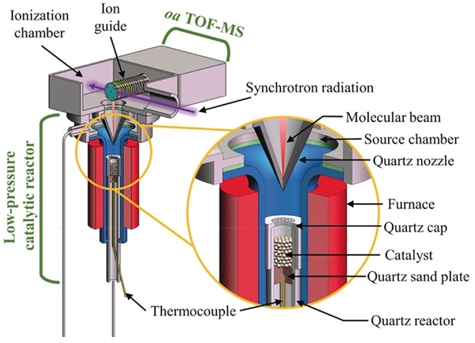Utilizing synchrotron-based SVUV-PIMS technique to capture (CHO)Cu1* species in dimethyl oxalate hydrogenation
DOI:
https://doi.org/10.18686/cest.v2i3.206Keywords:
SVUV-PIMS; dimethyl oxalate hydrogenation; copper nanoparticles; dealuminated Beta zeolite; intermediates; catalyst stabilityAbstract
Utilizing synchrotron vacuum ultraviolet photoionization mass spectrometry (SVUV-PIMS) to capture intermediates has significantly enhanced the understanding of catalytic reactions. This commentary introduced the structure of SVUV-PIMS and then revisited an excellent work in science that utilized SVUV-PIMS to elucidate the mechanisms of dimethyl oxalate (DMO) hydrogenation into ethylene glycol over copper nanoparticles (Cu NPs) supported on dealuminated Beta zeolite (Beta-deAl). The observation of key intermediates, particularly (CHO)Cu1* species, using SVUV-PIMS provided real-time, in-situ insights into the dynamic behavior of Cu NPs in DMO hydrogenation. The findings highlighted the formation of a silanol nest and the presence of metallic Cu and Cu2O phases following methanol treatment. This treatment helped maintain a small nanoparticle size, resulting in high EG yields and prolonged catalyst stability. Additionally, their catalyst addressed common issues, such as silica leaching, which often compromises the durability of CuSiO2-based catalysts. By re-examining their work, this commentary underscores the transformative potential of SVUV-PIMS in catalysis research, and the operando adaptation of intermediates in reactions is invaluable for developing more efficient and durable catalysts.

Downloads
Published
How to Cite
Issue
Section
License
Copyright (c) 2024 Zeeshan Abbasi, Jie Ren

This work is licensed under a Creative Commons Attribution 4.0 International License.
References
1. Li Y, Qi F. Recent applications of synchrotron VUV photoionization mass spectrometry: Insight into combustion chemistry. Accounts of Chemical Research. 2009; 43(1): 68-78. doi: 10.1021/ar900130b DOI: https://doi.org/10.1021/ar900130b
2. Li X, Sun Y, Xu J, et al. Selective visible-light-driven photocatalytic CO2 reduction to CH4 mediated by atomically thin CuIn5S8 layers. Nature Energy. 2019; 4(8): 690-699. doi: 10.1038/s41560-019-0431-1 DOI: https://doi.org/10.1038/s41560-019-0431-1
3. Musab Ahmed S, Ren J, Ullah I, et al. Ni‐based catalysts for CO2 methanation: Exploring the support role in structure‐activity relationships. ChemSusChem. 2024; 17(9). doi: 10.1002/cssc.202400310 DOI: https://doi.org/10.1002/cssc.202400310
4. Qi F. Combustion chemistry probed by synchrotron VUV photoionization mass spectrometry. Proceedings of the Combustion Institute. 2013; 34(1): 33-63. doi: 10.1016/j.proci.2012.09.002 DOI: https://doi.org/10.1016/j.proci.2012.09.002
5. Takahashi LK, Zhou J, Wilson KR, et al. Imaging with mass spectrometry: A secondary ion and VUV-photoionization study of ion-sputtered atoms and clusters from GaAs and Au. The Journal of Physical Chemistry A. 2009; 113(16): 4035-4044. doi: 10.1021/jp810408v DOI: https://doi.org/10.1021/jp810408v
6. Wen W, Yu S, Zhou C, et al. Formation and fate of formaldehyde in methanol-to-hydrocarbon reaction: In situ synchrotron radiation photoionization mass spectrometry study. Angewandte Chemie International Edition. 2020; 59(12): 4873-4878. doi: 10.1002/anie.201914953 DOI: https://doi.org/10.1002/anie.201914953
7. Liu L, Lu J, Yang Y, et al. Dealuminated Beta zeolite reverses Ostwald ripening for durable copper nanoparticle catalysts. Science. 2024; 383(6678): 94-101. doi: 10.1126/science.adj1962 DOI: https://doi.org/10.1126/science.adj1962
8. van den Berg R, Parmentier TE, Elkjær CF, et al. Support functionalization to retard Ostwald ripening in copper methanol synthesis catalysts. ACS Catalysis. 2015; 5(7): 4439-4448. doi: 10.1021/acscatal.5b00833 DOI: https://doi.org/10.1021/acscatal.5b00833




.jpg)
.jpg)

